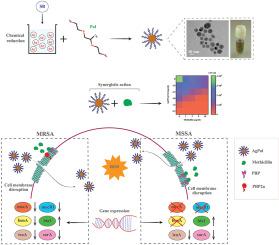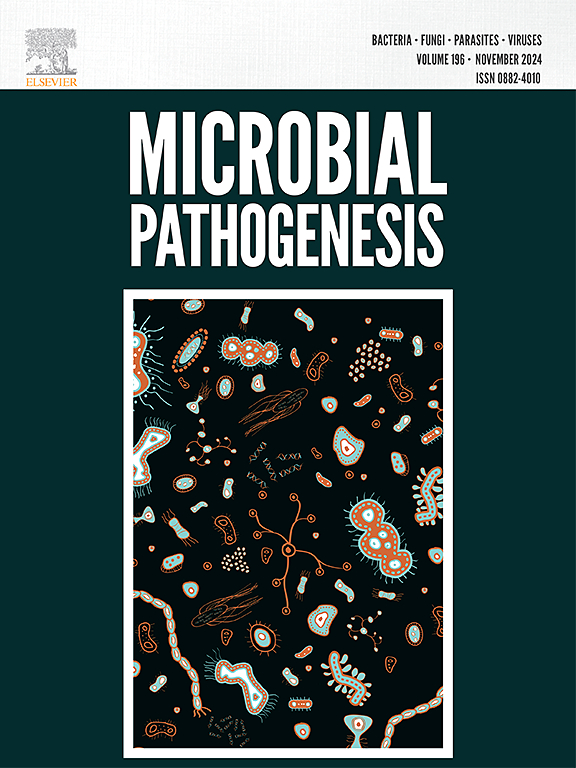治疗 MRSA 的一线希望:聚氧乙烯稳定银纳米粒子和甲氧西林对抗菌药耐药性的协同作用。
IF 3.3
3区 医学
Q3 IMMUNOLOGY
引用次数: 0
摘要
背景:细菌感染中的抗生素耐药性(包括耐甲氧西林金黄色葡萄球菌(MRSA)等耐药菌株)不断增加,因此需要创新的治疗方案。银纳米粒子在抗感染方面前景广阔,但毒性问题强调了剂量、大小、形状和表面化学等因素的重要性。因此,研究人员探索将聚氧乙烯作为稳定剂,以降低其毒性并增强对 MRSA 的抗菌效果:方法:通过化学还原法合成了用聚氧乙烯稳定的银纳米粒子(AgNPs@Pol),并使用紫外可见分光光度计、HR-TEM、DLS 和 Zeta 电位测量法对其进行了表征。随后,采用肉汤微稀释法评估了 AgNPs@Pol 单独或与甲氧西林复配对 MRSA 和甲氧西林敏感金黄色葡萄球菌(MSSA)的抗菌活性:结果:AgNPs@Pol 对 MRSA 和 MSSA 有显著疗效,在 9.7 μg/ml 的浓度下,菌落形成单位(CFU)减少了 100%。对 MRSA 和 MSSA 的最小抑菌浓度(MIC)分别为 8.6 μg/ml 和 4.3 μg/ml。当 AgNPs@Pol 与甲氧西林结合使用时,观察到了协同效应。用 AgNPs@Pol 处理两种菌株会增加活性氧(ROS)的产生,从而提高其抗菌活性。实时 qPCR 分析表明,这两种菌株中涉及抗菌药耐药性和细胞粘附性的基因都出现了下调。此外,3-(4,5-二甲基噻唑-2-基)-2,5-二苯基溴化四唑(MTT)试验表明,AgNPs@Pol 对 MCF-7、MG-63 和 NIH-3T3 细胞系的细胞毒性较低:结论:所开发的 AgNPs@Pol 对 MRSA 和 MSSA 具有广泛的胶体稳定性、强效抗菌活性以及与甲氧西林的协同作用。在原代细胞和体内模型中的进一步研究可能会验证其临床应用潜力。本文章由计算机程序翻译,如有差异,请以英文原文为准。

A silver lining in MRSA treatment: The synergistic action of poloxamer-stabilized silver nanoparticles and methicillin against antimicrobial resistance
Background
Increasing antibiotic resistance in bacterial infections, including drug-resistant strains like methicillin-resistant Staphylococcus aureus (MRSA), necessitates innovative therapeutic solutions. Silver nanoparticles are promising for combating infections, but toxicity concerns emphasize the importance of factors like dosage, size, shape, and surface chemistry. Hence, exploring poloxamer as a stabilizing agent to reduce its toxicity and enhance the antibacterial effect on MRSA is investigated.
Methods
Silver nanoparticles stabilized with poloxamer (AgNPs@Pol) were synthesized through the chemical reduction method and characterized using UV–visible spectrophotometer, HR-TEM, DLS, and Zeta potential measurements. Subsequently, the antibacterial activity of AgNPs@Pol alone and in combination with methicillin against MRSA and methicillin-susceptible S. aureus (MSSA) was evaluated using the broth microdilution method.
Results
AgNPs@Pol showed significant efficacy against MRSA and MSSA, achieving a 100 % reduction in colony-forming units (CFU) at 9.7 μg/ml. The minimum inhibitory concentration (MIC) against MRSA and MSSA was 8.6 μg/ml and 4.3 μg/ml, respectively. A synergistic effect was observed when AgNPs@Pol was combined with methicillin. Treatment with AgNPs@Pol increased reactive oxygen species (ROS) production in both strains, contributing to its antibacterial activity. Real-time qPCR analysis indicated the downregulation of genes involved in antimicrobial resistance and cell adhesion in both strains. Further, the 3-(4,5-dimethylthiazol-2-yl)-2,5-diphenyltetrazolium bromide (MTT) assay demonstrated low cytotoxicity for AgNPs@Pol against MCF-7, MG-63, and NIH-3T3 cell lines.
Conclusion
The developed AgNPs@Pol demonstrated extensive colloidal stability, potent antibacterial activity and synergistic effect with methicillin against MRSA and MSSA. Further studies in primary cells and in vivo models may validate its potential for clinical applications.
求助全文
通过发布文献求助,成功后即可免费获取论文全文。
去求助
来源期刊

Microbial pathogenesis
医学-免疫学
CiteScore
7.40
自引率
2.60%
发文量
472
审稿时长
56 days
期刊介绍:
Microbial Pathogenesis publishes original contributions and reviews about the molecular and cellular mechanisms of infectious diseases. It covers microbiology, host-pathogen interaction and immunology related to infectious agents, including bacteria, fungi, viruses and protozoa. It also accepts papers in the field of clinical microbiology, with the exception of case reports.
Research Areas Include:
-Pathogenesis
-Virulence factors
-Host susceptibility or resistance
-Immune mechanisms
-Identification, cloning and sequencing of relevant genes
-Genetic studies
-Viruses, prokaryotic organisms and protozoa
-Microbiota
-Systems biology related to infectious diseases
-Targets for vaccine design (pre-clinical studies)
 求助内容:
求助内容: 应助结果提醒方式:
应助结果提醒方式:


